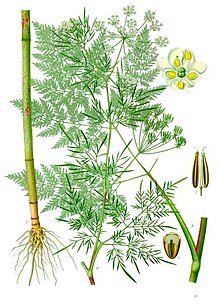Chaerophyllum bulbosum
This article needs additional citations for verification. (March 2013) |
| Chaerophyllum bulbosum | |
|---|---|

| |
| Scientific classification | |
| Kingdom: | |
| (unranked): | |
| (unranked): | |
| (unranked): | |
| Order: | |
| Family: | |
| Genus: | |
| Species: | C. bulbosum
|
| Binomial name | |
| Chaerophyllum bulbosum | |
| Synonyms[1] | |
| |
Chaerophyllum bulbosum is a species of flowering plant in the carrot family known by several common names, including turnip-rooted chervil, tuberous-rooted chervil, bulbous chervil, and parsnip chervil. It is native to Europe and Western Asia. It was a popular vegetable in the 19th century. Now virtually forgotten in Britain and the United States, root chervil is still used in French cuisine, in soups or stews.
This is a tall annual herb with fringelike divided leaves and large umbels of white flowers. The plant is cultivated on a small scale in parts of Europe for the edible root, which looks like a dark gray carrot with yellowish-white flesh. After harvest it is stored for a few months in cold temperatures, during which time the sugar content increases via hydrolysis of starch by amylases.[2]
Storage also allows the development of the root's flavor, which is reminiscent of chestnut. The root is prepared by boiling.
References
- ^ The Plant List: A Working List of All Plant Species, retrieved 22 December 2015
- ^ Geoffriau, E.; A. Suel, M. Briard; J.Y. Péron, O.J. Ayala Garay (2005), "Evolution of amylase activity in tuberous-rooted chervil (Chaerophyllum bulbosum L.) roots during storage at various temperatures", Acta Horticulturae, 682: 1153–1158, doi:10.17660/ActaHortic.2005.682.152
External links
- USDA GRIN Taxonomy, retrieved 22 December 2015
- C. bulbosum as a New Crop
- Photo gallery


